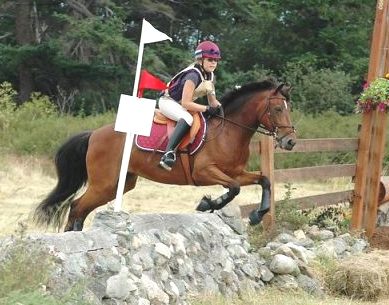|
CROSS COUNTRY
|
||
|
HOME | BIOLOGY | FILMS | GEOGRAPHY | HISTORY | INDEX | MUSIC | SOLAR BOATS | SPORT | SPONSORS |
||
|
Cross country equestrian jumping is an endurance test, and is the second phase of the sport of eventing. The object of the endurance test is to prove the speed, endurance and jumping ability of the true cross-country horse when he is well trained and brought to the peak of condition. At the same time, it demonstrates the rider's knowledge of pace and the use of this horse across country.
The endurance test includes four phases: Phases A and C, Roads and Tracks; Phase B, the Steeplechase; and Phase D, the Cross-Country. Each phase must be completed in a set time. Phase A of the roads and tracks is a warming-up period, usually done at a brisk trot, for the purpose of relaxing and loosening up both horse and rider. Phase A leads directly to the start for Phase B, the steeplechase. This phase is ridden at a strong gallop to achieve an average speed of 24 miles per hour with six to eight jumps. At the end of the steeplechase, the horse and rider go directly into Phase C, the second roads and tracks. This phase is very important for allowing the horse to relax and recover and to get his wind back to normal. The pace is usually a quiet trot, interspersed with periods of walking and an occasional relaxed canter. Some riders also dismount and run next to their horse during this section of the test.
The end of Phase C brings the pair to the ten-minute Vet Box prior to starting out on Phase D, the cross-country. Here the horse has a compulsory ten-minute rest allowing a panel of judges and veterinarians to check the horse's temperature, pulse, respiration, and soundness. If, in the opinion of the panel, the horse is not fit or sound enough to continue, he must be withdrawn from the competition. At this time the horse is sponged down, the tack is adjusted and he is prepared for the next phase. Those passing the inspection go to the start box ready for the most exciting phase of the whole endurance test.
The cross-country course is approximately two and three quarter to four miles long, is comprised of some twenty-four to thirty-six fixed and solid obstacles of great variety, and is ridden at a good gallop. Cross-country courses require horses and riders to be bold and smart and they also test stamina. Each combination of horse and rider must complete all four phases in order, on time and with as few penalties as possible. Phase D completes the endurance test of the three-day event.
In Olympic and World Championship competition, the total mileage to be covered on the speed and endurance phase can be up to twenty miles. The cross-country phase is the phase that appeals most to spectators and riders alike. It is the ultimate challenge to prepare a horse for this rigorous test. Unlike other sports, where only the human will and body are pitted against the clock, in eventing, or combined training, two minds and bodies have to work as one. As an additional attraction, eventing is the only high-risk Olympic sport that permits men and women to compete as equals. There are no separate divisions. Some of the top riders in the world today are women from many nations.
At the advanced level, cross country fences can be 3'11" high, with up to a 5 ft 11 in (1.80 m) spread at the top and 8'10" spread at the bottom of the fence. Fences with no height (i.e. ditches) can be up to 11'10" wide. Brush fences can be 4'7" at the top of the brush, and drops can be up to 6'7". There are between 32-40 jumping efforts on a course that is 3000-3800 meters long. The speed of an advanced level cross country course is ridden at 570 mpm (meters per minute).
Types of Cross Country Obstacles
LINKS
A - Z SPORTS INDEX
A taste for adventure capitalists
Solar Cola - a healthier alternative
|
||
|
This
website
is Copyright © 1999 & 2006 NJK. The bird |
||
|
AUTOMOTIVE | BLUEBIRD | ELECTRIC CARS | ELECTRIC CYCLES | SOLAR CARS |
